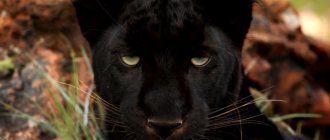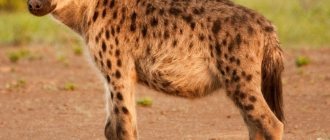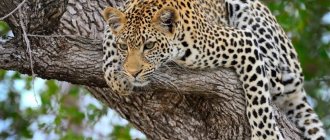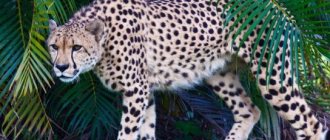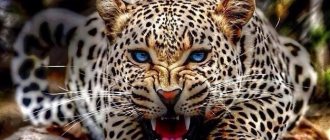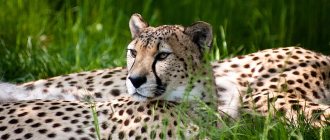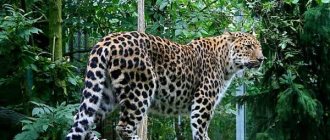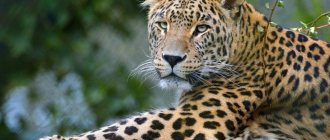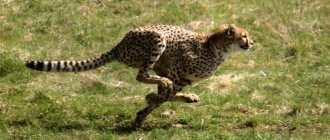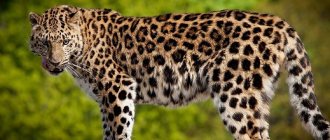Cheetah and Leopard are members of the cat family. Despite significant differences, they have much in common. Therefore, sometimes the average person often confuses these wild cats.
If we talk about appearance, the main difference between the two animals is that the cheetah always has characteristic black stripes on its face, which the leopard does not have. In addition, the latter can often be a bit plump, while the former, being the fastest animals on the planet, are distinguished by a very athletic physique, sometimes even thin.
Body structure
The leopard is a fairly large animal. It has a physique typical of cats: relatively short legs, a graceful, squat body. With a length of about 180 cm, it reaches a height of 75 cm. Weighs about 75 kg.
Leopard
The cheetah has a small head, long legs and a protruding chest. Its build resembles that of a hound dog. Very muscular, has no significant fat deposits. Significantly inferior in size to the leopard: the height at the withers is about 90 cm with a body length of 140 cm and a weight of 40-60 kg.
Cheetah
Another distinctive feature of cheetahs is that they do not retract their claws. They lost this ability in the process of evolution. Cheetahs use their claws as spikes when making sharp turns or when braking hard.
Description of the cheetah
This is a large representative of the animal world. Body length is 1.2-1.3 meters without tail. The tail is 75 cm long, the height at the withers is 90 cm. The weight of the animal ranges from 40-60 kilograms. In appearance, it has a muscular body compared to other cats.
The animal has long, thin legs, with partially retractable claws. This sign is not typical for felines. This ability provides them with good grip on the ground when running fast. Cubs have the ability to hide their claws until they reach 10-15 weeks.
The animal's tail is thin and long. Lowered, during accelerated running it creates the necessary balance. Has a small head size. The ears are small and rounded. The eyes are located on the front of the head, and has vision that can calculate the distance to the victim. There is a small mane.
The animal has sparse short fur and a sandy-yellowish color. Small dark spots are evenly and densely distributed throughout the body, except for the abdomen. Located on the nose, black stripes perform camouflage functions. With their help, it is hardly noticeable in the grass and bushes. Together with the spotted coat structure, the head stripes provide excellent camouflage.
This is the fastest animal, reaching speeds of up to 110 km/h. The average running pace of the animal is 93 km/h. Thanks to the aerodynamic structure of the body, it can develop such high speed in 3 seconds. It has a large chest and large lungs. Capable of taking 150 breaths per minute.
Hunting method
Leopards hunt alone. Night is considered the ideal time for this activity. They attack from an ambush. They can climb trees, so monkeys often become their prey. Often they drag their prey there so as not to share it with other predators.
Cheetahs can hunt in packs or groups of several individuals, which makes it easier for them to catch prey. They hunt exclusively during daylight hours. They have long and well-developed legs, so they run fast. In three seconds, the cheetah accelerates like a sports car (up to 110 kilometers per hour). They prefer to catch up with prey rather than wait in ambush. These predators do not climb trees; they hunt in open spaces.
Description of the leopard
Leopard is a large cat. Possesses flexibility and amazing ability to hide. Having a spotted yellow skin, he, like the lynx, is able to completely blend in with the branches and grass. Sometimes his hanging tail gives him away. This is a strong animal, but in terms of power it is inferior to the lion and tiger.
Not a single representative of the feline is capable of silently and deftly sneaking up on prey. The leopard is considered the most cunning cat. To lure prey to him, he can spend many hours in the sun, pretending to be dead. They tolerate heat and cold very well, even temperatures below zero.
It is a mistake to consider a leopard and a panther to be different animals. Panthers are dark-colored leopards. Color - from straw color to rusty brown. Young individuals have a lighter color: yellow, closer to grayish. Color depends on habitat and seasonality. The spots on the skin are ring-shaped and are called “rosettes.” Dark rings may not be interrupted. The boundaries of the spots are sharp, their location is unique for each animal, like prints for a person.
The animal is active at night. They are loners: they live and hunt on their own. After birth, they quickly adapt, showing their first hunting abilities. At first they are born blind, but gradually their vision becomes sharper. They are able to see the victim at a distance of 1.5 kilometers.
The animal makes a variety of sounds: hissing, growling, sounds in the form of screams and coughing.
The length of the body without the tail is 90-190 cm, while the tail ranges from 60 to 110 cm. The size depends on the habitat. Height at the withers is up to 80 cm. Weight ranges from 30 to 80 kilograms. Favorite animal food: young buffaloes, antelopes. Silently creeping up, makes a jump from close range. The main technique is to bite the scruff of the neck and throw it to the ground. Depending on the size of the victim, he hides with it or drags it up a tree.
Conclusions TheDifference.ru
- The cheetah's body is externally fragile, while the leopard's is massive.
- The cheetah is capable of developing enormous speed, while the leopard is noticeably slower.
- The cheetah does not drag its prey up a tree, but the leopard has this habit.
- Cheetahs have longer legs, while the leopard has shorter ones.
- The cheetah is smaller in head size than the leopard.
- Fat deposits in a fast cheetah are nonsense, but a leopard is lazier by nature and may well allow it.
- The pattern of the cheetah's skin consists of black spots, while that of the leopard forms rosettes.
- A cheetah cannot fully retract its claws, but a leopard can.
- The cheetah is a diurnal predator, while the leopard prefers twilight.
- Hunting in a pack is normal for a cheetah, but not for a leopard, it is a loner.
Species affiliation
In the cat family, there is a division into 2 subfamilies associated with genetic differences (the ancestor from which they descended): large and small cats. This division is relative and has nothing to do with the size of their representatives:
- Large: genus Panther and clouded leopards. Panthers include the following species: tiger, lion, snow leopard (not always), leopard, jaguar.
- Small: the genus of cheetahs, caracals, catopum (Temminka and Kalimantan cat), servals, lynxes (European or common, Canadian, Pyrenean or Spanish and bobcat), marbled, golden, Bengal cats (ALC), pumas and some others. The cheetah species is the only surviving member of the genus Acinonux (the actual genus of cheetahs).
1111
External differences
The most noticeable difference between the two cats can be seen on their faces - cheetahs have unique black tear stripes running down from the inner corners of the eyes to the nose, while leopards do not have this pattern. The spots on the skin of these animals are also different, if you look closely. The leopard's pattern consists of spots collected in rosettes, with a dark background inside, while the cheetah's clear dark spots do not form regular ring patterns.
These cats also differ in size: the cheetah is slender and graceful, has practically no fat deposits, only muscles. It has a small head and small rounded ears. The average weight of an adult cheetah is about 50 kg, body length is up to 140 cm including a long tail. The leopard is more massive, allows the presence of excess fat due to natural laziness, its body length reaches 250 cm, weight - up to 70 kg. Cheetahs have longer legs, which make them the recognized speed champion among land mammals. In addition, it has peculiar claws - the cheetah is the only representative of the cat family that is not able to retract them.
Habitat
Jaguar and leopard have many similar features, but differ in their habitat areas. The jaguar can only be found on the American continent in the tropics. Very rarely they enter mountainous areas up to 2 thousand meters high or the coastal zone of the ocean.
The leopard is the most widespread cat species of the Old World (Africa, Asia, Europe). It lives in mountainous, desert, forest or tropical areas. If the habitat has a cold climate, the animal’s fur will be thicker. In the forests there are individuals with a dark, almost black color. Its wide distribution allowed the formation of a large number of subspecies, but with the main characteristics inherent in the main one.
The cheetah lives almost everywhere in Africa, with a limited number of individuals living in the Middle East.
Comparison of leopard and cheetah
| Leopard | Cheetah | |
| Size | 5.25 to 7.55 feet long | 3.6 to 5 feet long |
| Weight | 37.4 to 143 lbs | 46 to 159 lbs |
| Habitat | Savannahs, forests, forests | Meadows, deserts |
| Lifespan | 10 to 12 years in the wild; up to 27 years in captivity | 8 years in the wild; 17 years in captivity |
| Body | Muscular, wide head and legs | Long, slender, flexible body, short head compared to the body, small, legs and tail long. |
| Group | Single males form groups | Otherwise lonely rescue of mothers and cubs |
| Claws | Fully retractable | Rather retractable |
| Voice | Roar, growl, purr, cough | Churrs, yips, gurgling |
| Active | Nocturnal lifestyle | Day |
Definition
Cheetah has a slender, muscular body, with virtually no noticeable fat deposits. At the first inattentive glance, one gets the impression that this is a rather fragile animal with a small head, high-set eyes and small ears. But this opinion is wrong. Everything in this 115-140 centimeter animal weighing up to 65 kg is aimed at creating a solid, swift, dangerous predator. The cheetah's legs feed it - it is the fastest mammal on the planet, capable of reaching speeds of up to 115 kilometers per hour. Of course, this pace cannot be maintained for long, so rapid runs are replaced by periods of rest. It lives in Africa, India, Western and Central Asia. Differs in daily hunting habits. It chooses small ungulates as prey: gazelles, calves, wildebeest, and often hares.
Cheetah
Leopard also has the “athletic” physique among predators. However, it is also somewhat denser. Belongs to the cat family. Its name is due to the fact that in ancient times it was considered a hybrid of a lion and a panther. A fairly large cat, but noticeably smaller than a tiger or lion. It has an elongated body, laterally compressed, quite slender and flexible. Relatively short but strong legs, small head, convex forehead. The size may vary depending on the habitat and feeding habits, but on average the length without a tail is about 90-190 centimeters, and with a tail it easily reaches 2.5-3 meters. Males are usually about a third larger than females. The leopard's habitat ranges from West Africa to the Far East. It feeds mainly on deer, antelope, and roe deer. In times of hunger, he does not disdain rodents, monkeys, birds and reptiles.
Leopard
